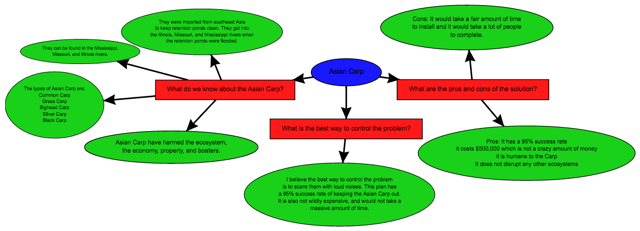Mike Jones, our Connecting Knowledge Grant winner and a STEM instructor and technology coach in the Bloomington School District 87 (Illinois), shares his insights on using Ideaphora in the classroom.
In simplest terms, the goal of science is to answer a question, regardless of the source. Often, this is done by introducing students to phenomena, which can be an event, piece of media or another item that helps students generate a question. It is the investigation of that question that allows for concept mapping to be a powerful tool in science inquiry, one of the three dimensions of learning in the Next Generation Science Standards.
After I introduce a phenomenon to my class, I allow them to generate questions, the more the better. Although, not all of these questions will be used later. This is a “think-pair-share” exercise where students generate individual questions first, group them together, then share. Students are asked to create multiple nodes on their concept maps for each of their questions without making any connections yet. One of the tools that Ideaphora offers is color choice for each node. We create a key where questions are red and answers are green. Students are asked to group common questions by use of connecting lines between nodes and try to find areas in which they can focus inquiry to a few driving questions. Later, students are asked to share their questions with either their lab group or class.
 Everything we do from this point on, from watching a video to reading an article, is evidence for their questions and captured on their concept maps in Ideaphora. The sources of their evidence are derived from Ideaphora’s library of open education resources or digital materials I’ve uploaded for them to use. Images and key text are generated from the resources for students to choose from and drag and drop into their maps. Even class activities, such as labs, are means to capture evidence that can be added to their maps. Through collaboration, new connections are made, evidence can be sorted, and questions can be refined. Through concept mapping, students are able to take abstract concepts and assign order and meaning to them to further their understanding.
Everything we do from this point on, from watching a video to reading an article, is evidence for their questions and captured on their concept maps in Ideaphora. The sources of their evidence are derived from Ideaphora’s library of open education resources or digital materials I’ve uploaded for them to use. Images and key text are generated from the resources for students to choose from and drag and drop into their maps. Even class activities, such as labs, are means to capture evidence that can be added to their maps. Through collaboration, new connections are made, evidence can be sorted, and questions can be refined. Through concept mapping, students are able to take abstract concepts and assign order and meaning to them to further their understanding.
At the end of the unit, students walk away with an artifact of their understanding that they can review and share at a later date, if necessary. Their map can also be used throughout as a formative assessment tool (more on this topic coming soon!). Students can then easily take their map to create an answer or give an explanation of their question, such as Claim, Evidence, and Reasoning.
For an example of how Mike used this process in his classroom on a science unit on invasive species, see his grant-winning entry. If you are interested in using Ideaphora in your classroom, try it now for free, or sign up to participate in our free Classroom Pilot Program.

